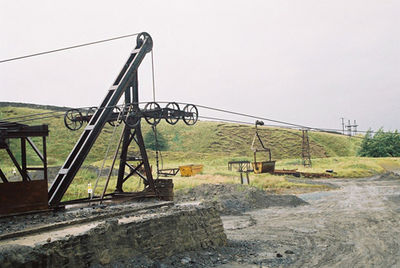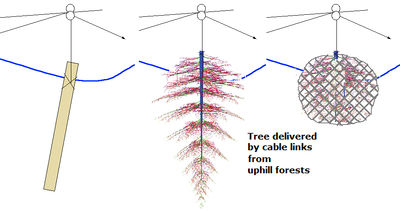Aerial Ropeways: Difference between revisions
mNo edit summary |
(inserted new section) |
||
| Line 2: | Line 2: | ||
Simple, inexpensive yet powerful technology. One of the most energy-efficient forms of transporting goods and people. Relatively easy (and quick) to set up, operate and take down again. Most common materials used were first wood and then steel. In mountainous regions, may be powered by gravity alone. | Simple, inexpensive yet powerful technology. One of the most energy-efficient forms of transporting goods and people. Relatively easy (and quick) to set up, operate and take down again. Most common materials used were first wood and then steel. In mountainous regions, may be powered by gravity alone. | ||
==Open source ropeway hardware for large-scale biochar transport== | |||
[[Biochar]] is becoming increasingly recognized as an important soil amendment and strategy to combat climate change. Some regions of the world, such as semi-arid regions, have abundant sunshine but little capacity for producing biomass. Other regions, such as forests, produce an abundance of biomass. This biomass may be at risk of wildfires, releasing gigatons of carbon dioxide into the atmosphere as part of the normal carbon cycle. Therefore, it has been proposed to produce biochar in forests and then transport it to biomass-poor regios. If done by ground transport (trucks, rail), this would be prohibitively expensive. | |||
Aerial ropeways may change that equation, as they have many qualities needed to transport large amounts of biochar energy-efficiently and inexpensively. Even topsoil could be transported in this way, rapid regeneration of degraded topsoil. | |||
[[File:Biochar ropeway.jpg|400px|thumb|right|part of mobile unit for biomass transport (image from: Biochar BC]] | |||
Some open source hardware development is required, and may include: | |||
* very large bins of sheet metal with steel supports (for the light-weight and bulky biochar) | |||
* poles that can be made of steel or wood | |||
* standardized wheels, possibly sand cast ? or CNC-machined | |||
* standardized steel rope to be used | |||
==External Links== | ==External Links== | ||
*Low-tech Magazine: [http://www.lowtechmagazine.com/2011/01/aerial-ropeways-automatic-cargo-transport.html "Aerial ropeways: automatic cargo transport for a bargain"] | *Low-tech Magazine: [http://www.lowtechmagazine.com/2011/01/aerial-ropeways-automatic-cargo-transport.html "Aerial ropeways: automatic cargo transport for a bargain"] | ||
| Line 9: | Line 20: | ||
* Appropedia: [http://www.appropedia.org/Aerial_Ropeways_in_Nepal Aerial Ropeways in Nepal] | * Appropedia: [http://www.appropedia.org/Aerial_Ropeways_in_Nepal Aerial Ropeways in Nepal] | ||
* Appropedia: [http://www.appropedia.org/Ropeway_in_the_Himalayas Ropeway in the Himalayas] | * Appropedia: [http://www.appropedia.org/Ropeway_in_the_Himalayas Ropeway in the Himalayas] | ||
[[Category:Food and Agriculture]] | |||
[[Category:Energy]] | |||
[[Category:Metalworks]] | |||
Revision as of 15:11, 31 January 2011
Simple, inexpensive yet powerful technology. One of the most energy-efficient forms of transporting goods and people. Relatively easy (and quick) to set up, operate and take down again. Most common materials used were first wood and then steel. In mountainous regions, may be powered by gravity alone.
Open source ropeway hardware for large-scale biochar transport
Biochar is becoming increasingly recognized as an important soil amendment and strategy to combat climate change. Some regions of the world, such as semi-arid regions, have abundant sunshine but little capacity for producing biomass. Other regions, such as forests, produce an abundance of biomass. This biomass may be at risk of wildfires, releasing gigatons of carbon dioxide into the atmosphere as part of the normal carbon cycle. Therefore, it has been proposed to produce biochar in forests and then transport it to biomass-poor regios. If done by ground transport (trucks, rail), this would be prohibitively expensive.
Aerial ropeways may change that equation, as they have many qualities needed to transport large amounts of biochar energy-efficiently and inexpensively. Even topsoil could be transported in this way, rapid regeneration of degraded topsoil.
Some open source hardware development is required, and may include:
- very large bins of sheet metal with steel supports (for the light-weight and bulky biochar)
- poles that can be made of steel or wood
- standardized wheels, possibly sand cast ? or CNC-machined
- standardized steel rope to be used
External Links
- Low-tech Magazine: "Aerial ropeways: automatic cargo transport for a bargain"
- Practical Action: "Technical Information Online Ropeways - Aerial Ropeways in Nepal"
- Appropedia: Aerial Ropeways in Nepal
- Appropedia: Ropeway in the Himalayas

